职专英语教案拓展模块Unit1
- 格式:doc
- 大小:105.50 KB
- 文档页数:8
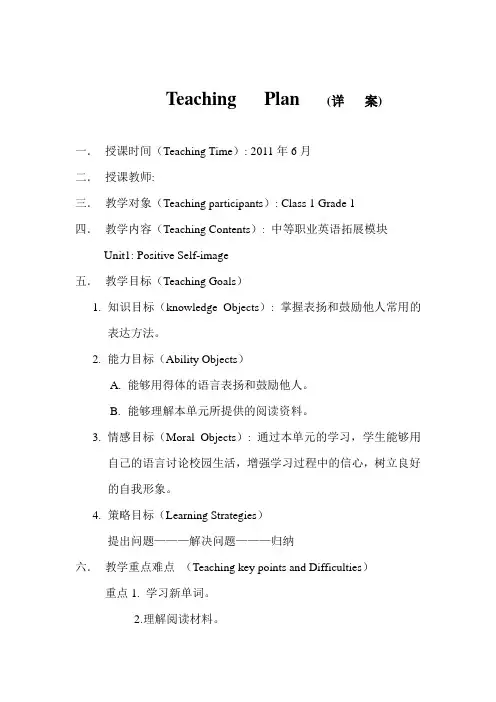
Teaching Plan(详案)一.授课时间(Teaching Time): 2011年6月二.授课教师:三.教学对象(Teaching participants): Class 1 Grade 1四.教学内容(Teaching Contents): 中等职业英语拓展模块Unit1: Positive Self-image五.教学目标(Teaching Goals)1.知识目标(knowledge Objects): 掌握表扬和鼓励他人常用的表达方法。
2.能力目标(Ability Objects)A.能够用得体的语言表扬和鼓励他人。
B.能够理解本单元所提供的阅读资料。
3.情感目标(Moral Objects): 通过本单元的学习,学生能够用自己的语言讨论校园生活,增强学习过程中的信心,树立良好的自我形象。
4.策略目标(Learning Strategies)提出问题———解决问题———归纳六.教学重点难点(Teaching key points and Difficulties)重点1. 学习新单词。
2.理解阅读材料。
难点:掌握阅读材料中的语言知识点。
七.教学方法(Teaching Methods): 课堂讲授八.教学辅助(Teaching Aids)1.Multimedia2.Blackboard九.教学步骤(Procedures)任务一(task 1)Greetings and Lead-in 导入T: Hello boys and girls. I’m your English teacher, I’m a positive girl and I’m enthusiastic at everything. I believe I can be a useful person and do great things for our society. How about you?Ss: …T: I have learned some students choose vocational school because of bad grades. So these students become more and more unconfident about themselves. How do you think about it? Which is more important, to be popular or to study well?Ss: …T: Do you want to change your self-image?Ss: …T: Today we’ll learn how to build positive self-image任务二(task 2)Text 1 阅读步骤1(Step 1)Help students to learn new words and finish the task.帮助学生学习新单词并完成词语搭配。
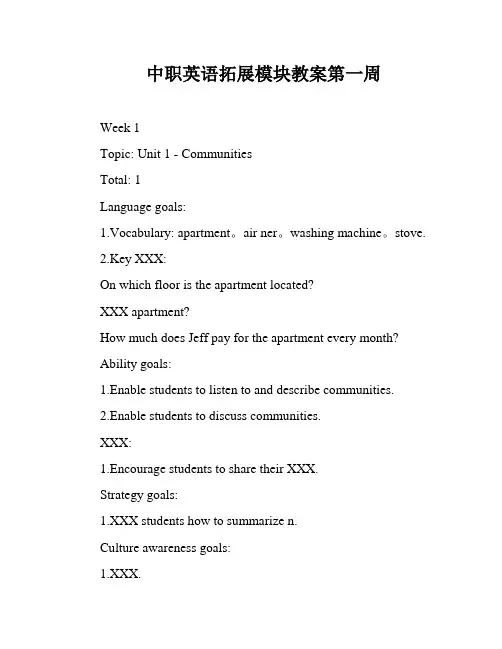
中职英语拓展模块教案第一周Week 1Topic: Unit 1 - CommunitiesTotal: 1Language goals:1.Vocabulary: apartment。
air ner。
washing machine。
stove.2.Key XXX:On which floor is the apartment located?XXX apartment?How much does Jeff pay for the apartment every month? Ability goals:1.Enable students to listen to and describe communities.2.Enable students to discuss communities.XXX:1.Encourage students to share their XXX.Strategy goals:1.XXX students how to summarize n.Culture awareness goals:1.XXX.XXX:1.ListeningXXX and methods:Step 1:XXX's activities:Ask students how their week was and if they have any XXX.XXX.Have students read and XXX they have done before in Activity 1.Students' activities:XXX.XXX.Read and XXX they have done before in Activity 1.XXX: 5 minutes.How many bedrooms does the apartment have。
What can Jeff see from the apartment。

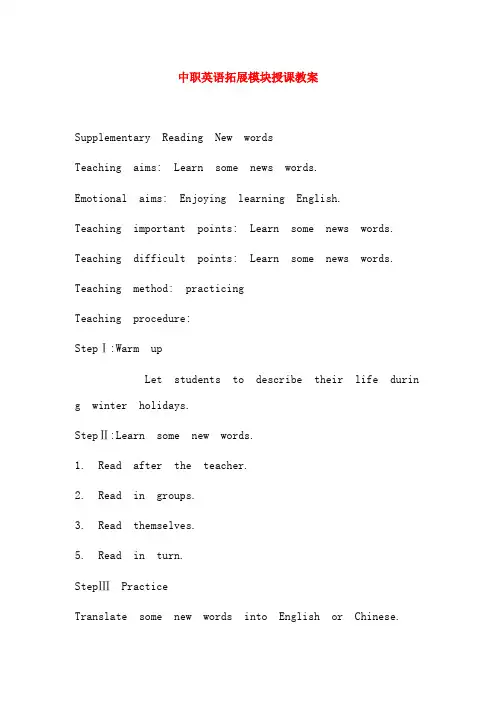
中职英语拓展模块授课教案Supplementary Reading New wordsTeaching aims: Learn some news words.Emotional aims: Enjoying learning English.Teaching important points: Learn some news words. Teaching difficult points: Learn some news words. Teaching method: practicingTeaching procedure:StepⅠ:Warm upLet students to describe their life durin g winter holidays.StepⅡ:Learn some new words.1. Read after the teacher.2. Read in groups.3. Read themselves.5. Read in turn.StepⅢPracticeTranslate some new words into English or Chinese.StepⅣSummary and homework Recite news words. Teaching thinking: Students are active in class, and they can react to the teacher.Blackboard design: Some word formation.Supplementary ReadingTeaching aims: 理解文章的基本内容Emotional aims:克服学习中的困难Teaching important points: 掌握教学目标中的Key words和useful Expressions的基本用法Teaching difficult points: 掌握教学目标中的Key words和useful Expressions的基本用法Teaching method: practicing and reading.Teaching procedure:StepⅠRevisionReview some words.StepⅡReading1. Read the text carefully in a few minutes discuss in groups and answer in turn.2. Answer the following questions.What is the body language/nonverbal communication? StepⅢKey words和Useful Expressions①We commumcate with each other by means of language.我们通过语言相互交流。
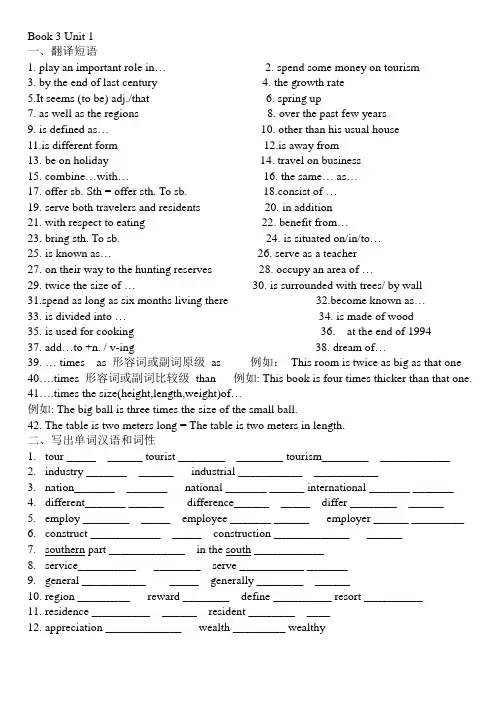
Book 3 Unit 1一、翻译短语1. play an important role in…2. spend some money on tourism3. by the end of last century4. the growth rate5.It seems (to be) adj./that6. spring up7. as well as the regions 8. over the past few years9. is defined as…10. other than his usual house11.is different form 12.is away from13. be on holiday 14. travel on business15. combine…with…16. the same… as…17. offer sb. Sth = offer sth. To sb. 18.consist of …19. serve both travelers and residents 20. in addition21. with respect to eating 22. benefit from…23. bring sth. To sb. 24. is situated on/in/to…25. is known as…26. serve as a teacher27. on their way to the hunting reserves 28. occupy an area of …29. twice the size of …30. is surrounded with trees/ by wall31.spend as long as six months living there 32.become known as…33. is divided into …34. is made of wood35. is used for cooking 36. at the end of 199437. add…to +n. / v-ing 38. dream of…39. … times as 形容词或副词原级as 例如:This room is twice as big as that one 40….times 形容词或副词比较级than 例如: This book is four times thicker than that one. 41….times the size(height,length,weight)of…例如: The big ball is three times the size of the small ball.42. The table is two meters long = The table is two meters in length.二、写出单词汉语和词性1.tour _____ ______ tourist ________ ________ tourism________ ____________2.industry _______ ______ industrial ___________ ___________3.nation_______ _______ national _______ ______ international _______ _______4.different_______ ______ difference______ _____ differ ________ ______5.employ ________ _____ employee _______ ______ employer ______ _________6.construct ____________ _____ construction _____________ ______7.southern part _____________ in the south ____________8.service__________ ________ serve ___________ _______9.general ___________ _____ generally ________ ______10.region _________ reward ________ define __________ resort __________11.residence __________ ______ resident ________ ____12.appreciation _____________ wealth _________ wealthy。


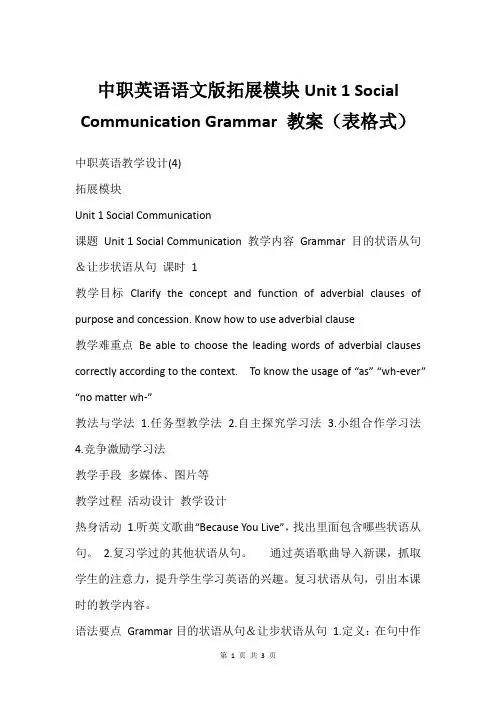
中职英语语文版拓展模块Unit 1 Social Communication Grammar 教案(表格式)中职英语教学设计(4)拓展模块Unit 1 Social Communication课题Unit 1 Social Communication 教学内容Grammar 目的状语从句&让步状语从句课时1教学目标Clarify the concept and function of adverbial clauses of purpose and concession. Know how to use adverbial clause教学难重点Be able to choose the leading words of adverbial clauses correctly according to the context. To know the usage of “as” “wh-ever” “no matter wh-”教法与学法 1.任务型教学法 2.自主探究学习法 3.小组合作学习法4.竞争激励学习法教学手段多媒体、图片等教学过程活动设计教学设计热身活动1.听英文歌曲“Because You Live”,找出里面包含哪些状语从句。
2.复习学过的其他状语从句。
通过英语歌曲导入新课,抓取学生的注意力,提升学生学习英语的兴趣。
复习状语从句,引出本课时的教学内容。
语法要点Grammar目的状语从句&让步状语从句1.定义:在句中作状语的从句叫作状语从句。
它可以用来修饰谓语、定语、状语或整个句子。
状语从句通常由一个连词或起连词作用的词组引导,在句中的位置比较灵活。
2.分类:3.目的状语从句在复合句中作目的状语的从句叫作目的状语从句,一般置于句尾。
引导词:so that、in order that、for fear (that)、in case(that)等Eg.Speak louder so that the people in the hall can all hear you. I hurried through my work in order that I could be in time for wonderful programmers. I'm studying hard for fear that I should fail. Don't play by the river in case you fall in. 注意:目的状语从句中常常使用may,might,can,could,shall,should,will,would等情态动词。
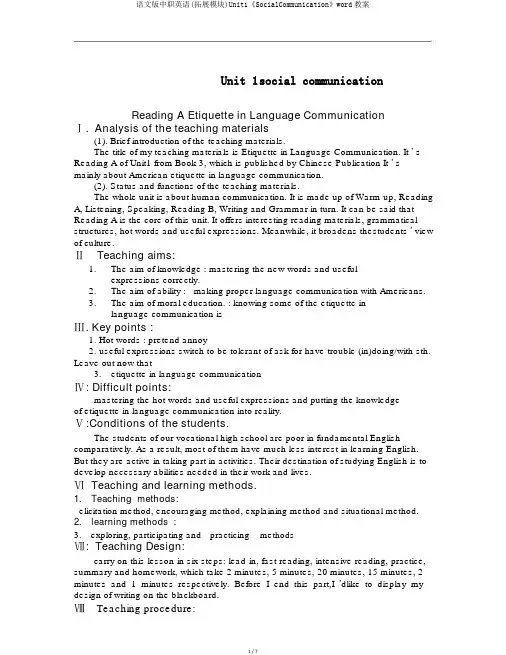
Unit 1s ocial communicationReading A Etiquette in Language CommunicationⅠ. Analysis of the teaching materials(1). Brief introduction of the teaching materials.The title of my teaching materials is Etiquette in Language Communication. It ’ s Reading A of Unit1 from Book 3, which is published by Chinese Publication It ’ s mainly about American etiquette in language communication.(2). Status and functions of the teaching materials.The whole unit is about human communication. It is made up of Warm-up, Reading A, Listening, Speaking, Reading B, Writing and Grammar in turn. It can be said that Reading A is the core of this unit. It offers interesting reading materials, grammatical structures, hot words and useful expressions. Meanwhile, it broadens thestudents ’ view of culture.ⅡTeaching aims:1.The aim of knowledge : mastering the new words and usefulexpressions correctly.2.The aim of ability : making proper language communication with Americans.3.The aim of moral education. : knowing some of the etiquette inlanguage communication isⅢ. Key points :1.Hot words : pretend annoy2. useful expressions switch to be tolerant of ask for have trouble (in)doing/with sth. Leave out now that3.etiquette in language communicationⅣ: Difficult points:mastering the hot words and useful expressions and putting the knowledgeof etiquette in language communication into reality.Ⅴ:Conditions of the students.The students of our vocational high school are poor in fundamental English comparatively. As a result, most of them have much less interest in learning English. But they are active in taking part in activities. Their destination of studying English is to develop necessary abilities needed in their work and lives.ⅥTeaching and learning methods.1.Teaching methods:elicitation method, encouraging method, explaining method and situational method.2.learning methods :3. exploring, participating and practicing methodsⅦ: Teaching Design:carry on this lesson in six steps: lead-in, fast reading, intensive reading, practice, summary and homework, which take 2 minutes, 5 minutes, 20 minutes, 15 minutes, 2 minutes and 1 minutes respectively. Before I end this part,I ’dlike to display my design of writing on the blackboard.ⅧTeaching procedure:Step 1 Lead in (2’)Tell a story , showing some pictures with wrong manners→Find mistakes××①②××③④Then ask the question:“What are wrong manners?”The students needn’tanswer the questionStep 2 fast reading (5)read fast → showing the pictures again→ give their answersThen ask the question:“What we should say/do here?”??①②??③③④Step 3 Intensive reading(20)1.read carefully ,then ask the question:“Why should we behave so?”2.key words and useful expressions→long sentences→ expansionokok②①ok ok③④Key words and expressions:In this step, I ’lltake three steps to present the key words and useful expressions. First, the usage. Then, show one or two model sentences. Last, to get the students to participate and practise, give them one or two sentences as exercises. The exercises can be in different forms, such as, filling in blanks, translating, correcting mistakes, and so on. All the exercises are done by the students themselves.be tolerant of/towards:Usage: be tolerant of/towards +n./ pron .Model sentences:1.Mr. Smith is not very tolerant of/towards others .2.We should always be tolerant of the views of others even if we disagree with them. Exercises:1.Fill in the blank with the right form of the given words:Her own mistakes made her very____( tolerant) of/towards others.Have some/no trouble(in)Usage: have some/no trouble(in) doing sth.Model sentences:I had some trouble (in) reading the letter . His handwriting is very bad.They had no difficulty in understanding what he said.Exercises:Translate the Chinese sentence into English:他们绝不费劲就找到了我的家。
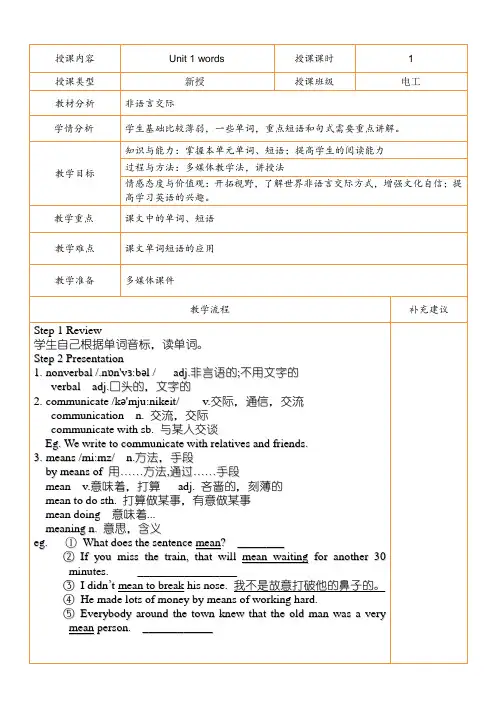

中职英语拓展模块授课教案Supplementary ReadingTeaching aims: 理解文章的基本内容Emotional aims:学会合作学习Teaching important points: 掌握教学目标中的Key words和useful Expressions的基本用法Teaching difficult points: 掌握教学目标中的Key words和useful Expressions的基本用法Teaching method: practicing and reading.Teaching procedure:StepⅠRevisionReview some words.StepⅡReading1. Read the text carefully in a few minutes.2. U nderstand the text.StepⅢKey words和Useful Expressions⑤When we agree with others, we express our feeling by nodding our heads, while shaking the head means disagreement.当我们与他人争论时,用点头来表示同意,而州摇头表示不同意。
agree with的意思是“同意……”“赞成……”,后面接指人或表示“意见”“看法”的词。
We all agree with her.我们都同意她的意见。
I quite agree with what you said.我很同意你说的话。
agree to的意思是“同意……”“赞成…”,后接表示“提议”“办法”“计划”等词语。
例如:I agree to the proposal (the plan).我同意这个计划。
、Do you agree to this arrangement?你赞成这个安排吗?agree on“对……取得一致意见”,主语常常是协商一件事的人们或单位,后面常接表示具体协议的文件、计划、行动等名词。
最新中职英语拓展模块授课教案:Unit1SocialCommunication中职英语拓展模块授课教案Unit1 Social CommunicationNew wordsTeaching aims: Learn some news words.Emotional aims: Enjoying learning English.Teaching important points: Learn some news words. Teaching difficult points: Learn some news words. Teaching method: practicing Teaching procedure:StepⅠ:Warm upLet students to describe their life durin g winter holidays.StepⅡ:Learn some new words.1. Read after the teacher.2. Read in groups.3. Read themselves.4. Read in turn.StepⅢPracticeTranslate some new words into English or Chinese.StepⅣSummary and homework Recite news words. Teaching thinking: Students are active in class, and they can react to the teacher.Blackboard design: Some word formation.native pretend misunderstand communicate meanscontact soap admitpolitely engagewave shake explainrude lostrather finger formswitch conversationsymbol consider tasteface wheneverpresident thus properaudience overviewWarming upTeaching aims: Learn some news words.Emotional aims: Learn some manners in language commu nication.Teaching important points: Discuss some questions. Teaching difficult points: Learn some news words. Teaching method: practicing and discussing.Teaching procedure: StepⅠRevisionReview some words.StepⅡDiscussion 讨论课文插图Now look at the picture in the reading text "Etiquette in Language Communication".What can you see in it?-From the picture, we can see a woman is t alking with a man. But the manlooks a bit uneasy, maybe he is nervous. Obviously it's not a smooth language communication.StepⅢ提示相关生词和短语,如:native speaker, native language, have trouble in doi ng sth, pretend to do sth, repeat, explain, manneStepⅣ分组讨论下面的3个问题,要求学生用英语如实回答:1) Have you ever talked with an English native spe aker?2) What would you do when you don't know how to say something in English?3) What would you do when you don't understand oth ers inEnglish?StepⅤSummary and homework Recite news words. Teaching thinking: Students are active in class, and they can react to the teacher.Blackboard design:native speaker,native language,have trouble in doingTeaching aims: 理解文章的基本内容Emotional aims:享受学习英语的乐趣Teaching important points: 掌握教学目标中的Key words和useful Expressions的基本用法Teaching difficult points: 掌握教学目标中的Key words和useful Expressions的基本用法Teaching method: practicing and reading.Teaching procedure:StepⅠRevisionReview some words.StepⅡReadingAnswer the following questions.(1)Why are foreigners usually tolerant of non - nat ive speakers' English?(2)Why is it rude to talk with a person in your native language and leave your American friends stan ding there?带着问题用3-4分钟时问快速阅读课文,了解要求掌握的信息。
第一周Topic Unit 1 Communities Total1 Language goals1. Words & expressions:the apartment,Air conditioner. Washingmachine.Stove.2.Key sentences:Which floor is the apartment on?What is provided in the apartment?How much does the apartment cost Jeff every month?Ability goalsEnable the students to listen to materials that describe Communities.Enable the students to talk about Communities.Emotion & attitude goalsEnable the students to share their happiness withothers Strategy goalsLearn how to summarize informationCulture awareness goalsLearn the western attitude about Communities.Teaching important pointsListeningTeaching procedures and waysSteps Teacher’s activities Students ’ activities Teaching TimereferenceStep11T:How was your answer the questions Brainst5min Lead in Communities. 2.Learn the new words orming s the activities that and phrases.Ss talk about and read and tick theteach the phrases in activities they didActivity 1before in Activity 1Step21. Play the tape and 1.Ss read the sentences Tape5min Listenin get the Ss to finish and get the meaning of recordi sg Activity2each sentence.ng2.Ss listen and match.Step3Which floor is the 1.Look and talk about Tape12 Listenin apartment on?the pictures.recordi mins g What is provided in 2.Ss listen and tick .ng&the apartment? 3.Ss listen to the tapespeaking Howmanybedrooms does and finish Activity2the apartment have? 4. Ss repeat after theWhat can Jeff see from tapethe apartment? 5.Ss retell theHow much does the dialogue.apartment cost Jeffevery month?2. Check their workStep 4their answers Ss choose the right Role-pl10 Reading 2. Walk around the answers aying mins classroom and offerhelp if necessary.Step 5Walk around the Ss make conversations Role-pl10 Practice classroom and offer aying mins help if necessary.Step 6Give marks to each Ss talk about their2 Assessin group.performance mins gHomework Wb P1-3 EX1,2,3Blackboard Unit 1 CommunitiesdesignWhich floor is the apartment on?What is provided in the apartment?How many bedrooms does the apartment have?What can Jeff see from the apartment?How much does the apartment cost Jeff every month?Summarie s Students were not used to studying after a long winterThey didn ’t concentrate on lessons. So this lesson is not successful.vacation.Topic Unit 1 Communities Total2 Language goals1.Words & expressions:swallows dustbins ensure Property Management Center rubbish-sorting brochures2.Key sentences:swallows his breakfast and rushes to the dustbins beside the gate ofhis community. Four other playmates are waiting for him there to check the rubbish and to ensure it is sorted correctly.3.Ability goalsEnable the students to read the materialsEnable the students to talk about the story.Emotion & attitude goalsEnable the students to share their happiness with othersStrategy goalsLearn how to summarize informationCulture awareness goalsLearn the western attitude about Communities.Teaching important pointsRead the materials.Teaching procedures and waysSteps Teacher’s activities Students ’ activities Teaching TimereferenceStep 11T:How was your 1.Read and match Brainst5min Lead in Communities. 2.Learn the new words orming s the activities that and phrases.Ss talk about and 3.Ss read and matchteach the phrases in For Sale WantedActivity 6Notice Join Us,1,2,3Right NowStep21. Play the tape and Listenin get the Ss to finish g Activity7Step3Listening 1. Ss read the sentences Tape5min and get the meaning of recordi s each sentence.ng1. Look and talk about Tape12 the pictures.recordi mins2. Ss listen and choose.ng& 2. Check their work 3.Ss readspeaking 4.Ss repeat after thetape5. Ss retell the storyStep 4their answers Ss choose the right Role-pl10 Reading 2. Walk around the answers aying mins classroom and offerhelp if necessary.Step 5Walk around the Ss make conversations Role-pl10 Practice classroom and offer aying mins help if necessary.Step 6Give marks to each Ss talk about their2 Assessin group.performance mins gHomework Activity8Blackboard Unit 1 CommunitiesdesignAll of the buildings are equipped with three dustbinsThey handed out ___________________________________They explained _____________________________________Summarie Students were not used to studying s g winter vacation. They didn ’t concentratelesson is not successful.afteron lessons.a lonSo thisTopic Unit 1 Communities Total3 Language goals1.Words & expressions:donated ,put up ,performance,move2.Key sentences:After supper, Jerry and his friends beganJerry and his friends have toJerry and his classmates planned toAbility goalsEnable the students to read the materialsEnable the students to talk about the story.Emotion & attitude goalsEnable the students to share their happiness with othersStrategy goalsLearn how to summarize informationCulture awareness goalsLearn the western attitude about Communities.Teaching important pointsWritingTeaching procedures and waysSteps Teacher’s activities Students ’ activities Teaching TimereferenceStep11T:How was your 1.Read and match Brainst5min Lead in Communities. 2.Learn the new words orming s the activities that and phrases.Ss talk about andteach the phrases inActivity 6,1,2,3Step21. Play the tape and 1.Ss read the sentences Tape5min Look and get the Ss to finish and get the meaning of recordi s complete Activity9each sentence.ng. 2.Look and completeStep3 1.Look and talk about Tape12the pictures.recordi mins2.Ss listen and choose.ng2. Check their work3.Ss read4. Ss repeat after thetape5. Ss retell the storyStep 4their answers Ss write out the right Role-pl102. Walk around the answers aying minsclassroom and offerhelp if necessary.Step 5Walk around the Read and complete.Role-pl10 Practice classroom and offer aying mins help if necessary.Step 6Give marks to each Ss talk about their2 Assessin group.performance mins gHomework Activity8Blackboard Unit 1 CommunitiesdesignAfter supper, Jerry and his friends began _____________Jerry and his friends have to________________Jerry and his classmates planned to___________Summarie Students were not used to studying s g winter vacation. They didn ’t concentratelesson is not successful.afteron lessons.a lonSo this。